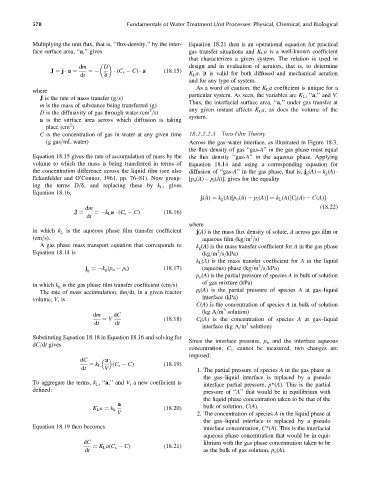Page 623 - Fundamentals of Water Treatment Unit Processes : Physical, Chemical, and Biological
P. 623
578 Fundamentals of Water Treatment Unit Processes: Physical, Chemical, and Biological
Multiplying the unit flux, that is, ‘‘flux-density,’’ by the inter- Equation 18.21 then is an operational equation for practical
face surface area, ‘‘a,’’ gives gas transfer situations and K L a is a well-known coefficient
that characterizes a given system. The relation is used in
dm D design and in evaluation of aerators, that is, to determine
(18:15)
J ¼ j a ¼ ¼ (C s C) a K L a. It is valid for both diffused and mechanical aeration
dt d
and for any type of system.
As a word of caution, the K L a coefficient is unique for a
where
particular system. As seen, the variables are K L , ‘‘a,’’ and V.
J is the rate of mass transfer (g=s)
Thus, the interfacial surface area, ‘‘a,’’ under gas transfer at
m is the mass of substance being transferred (g)
2
D is the diffusivity of gas through water (cm =s) any given instant affects K L a, as does the volume of the
system.
a is the surface area across which diffusion is taking
2
place (cm )
C is the concentration of gas in water at any given time 18.2.2.2.3 Two-Film Theory
(g gas=mL water) Across the gas–water interface, as illustrated in Figure 18.3,
the flux density of gas ‘‘gas-A’’ in the gas phase must equal
Equation 18.15 gives the rate of accumulation of mass by the the flux density ‘‘gas-A’’ in the aqueous phase. Applying
volume to which the mass is being transferred in terms of Equation 18.14 and using a corresponding equation for
the concentration difference across the liquid film (see also
diffusion of ‘‘gas-A’’ in the gas phase, that is, j g (A) ¼ k g (A)
Eckenfelder and O’Connor, 1961, pp. 76–81). Now group- [p o (A) p i (A)], gives for the equality
ing the terms D=d, and replacing these by k L , gives
Equation 18.16,
j(A) ¼ k g (A)[p o (A) p i (A)] ¼ k L (A)[C i (A) C(A)]
dm (18:22)
¼ k L a (C s C) (18:16)
dt
J ¼
where
in which k L is the aqueous phase film transfer coefficient j(A) is the mass flux density of solute, A across gas film or
(cm=s). aqueous film (kg=m =s)
2
A gas phase mass transport equation that corresponds to k g (A) is the mass transfer coefficient for A in the gas phase
2
Equation 18.14 is (kg=m =s=kPa)
k L (A) is the mass transfer coefficient for A in the liquid
2
j ¼ k g (p o p i ) (18:17) (aqueous) phase (kg=m =s=kPa)
g
p o (A) is the partial pressure of species A in bulk of solution
in which k g is the gas phase film transfer coefficient (cm=s). of gas mixture (kPa)
The rate of mass accumulation, dm=dt, in a given reactor p i (A) is the partial pressure of species A at gas–liquid
volume, V,is interface (kPa)
C(A) is the concentration of species A in bulk of solution
3
(kg A=m solution)
dm dC
¼ V (18:18) C i (A) is the concentration of species A at gas–liquid
dt dt 3
interface (kg A=m solution)
Substituting Equation 18.18 in Equation 18.16 and solving for
Since the interface pressure, p i , and the interface aqueous
dC=dt gives
concentration, C i , cannot be measured, two changes are
imposed:
dC
a
¼ k L (C s C) (18:19)
dt V 1. The partial pressure of species A in the gas phase at
the gas–liquid interface is replaced by a pseudo
To aggregate the terms, k L , ‘‘a,’’ and V, a new coefficient is interface partial pressure, p*(A). This is the partial
defined: pressure of ‘‘A’’ that would be in equilibrium with
the liquid phase concentration taken to be that of the
a bulk of solution, C(A).
K L a ¼ k L (18:20)
V 2. The concentration of species A in the liquid phase at
the gas–liquid interface is replaced by a pseudo
Equation 18.19 then becomes interface concentration, C*(A). This is the interfacial
aqueous phase concentration that would be in equi-
dC librium with the gas phase concentration taken to be
¼ K L a(C s C) (18:21)
dt as the bulk of gas solution, p o (A).

